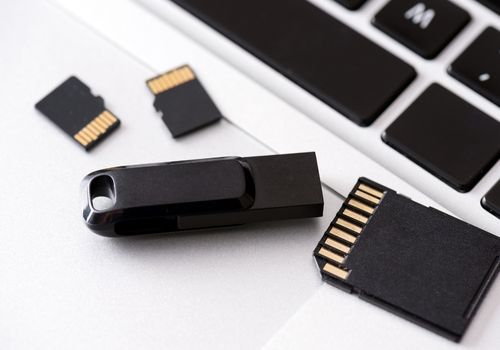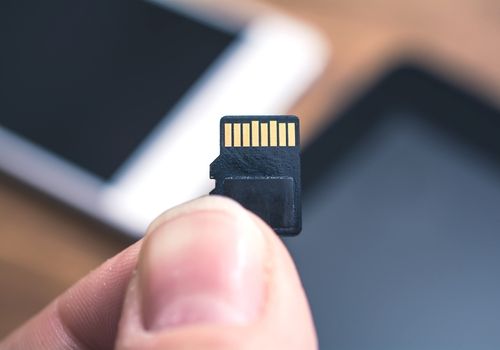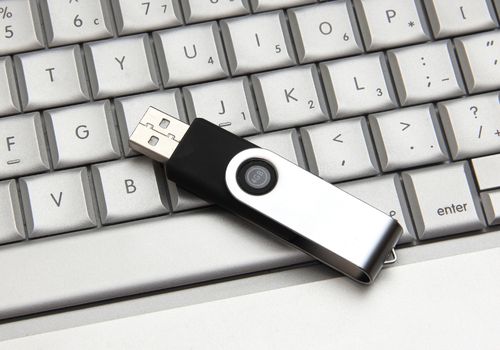
You might be unsure about whether to choose an SD card or flash drive for your storage needs. You might need an SD card to store files on a portable device like a smartphone, camera, or tablet. Flash drives are more reliable with faster transfer speeds and are suitable for USB-enabled devices like your laptop or computer.
These storage devices are similar in a lot of ways, so this can make it tough to choose between them. I've tackled this issue many times when trying to store video data and large files.
If you're trying to decide which type of storage device fits your needs better when it comes to the SD card vs flash drive debate, this guide is for you. Let’s jump into it.
Contents
Before you jump into comparing SD cards and flash drives, let’s talk about the fundamentals first.

SD cards are removable, rewritable storage devices. They typically have very small dimensions, making them perfect for smaller devices like a smartphone or an action camera.
SD cards come in three different sizes: mini-SD, microSD, and standard SD.
They can also be sorted into five families depending on their storage space. The most common are the SD High Capacity cards which can store up to 2GB, and the SD eXtended Capacity Cards, which hold up to 32GB. The SD Ultra capacity cards hold up to 128TB of data.
Flash drives, also known as USB drives or USB flash drives, are portable storage devices that interface with a USB port. They come in a variety of sizes ranging from 128MB to 2TB.
There are 5 different USB types depending on their USB standard. These are USB 2.0, USB 3.0, USB 3.1, USB 3.2, and USB 4.0 flash drives.
They are backward and forward-compatible, so a USB flash drive with USB 3.2 will work with a computer with USB ports on the 4.0 standard. They differ mainly in terms of cost and speed.
The SD card vs flash drive debate isn't easily settled by giving a quick answer. Both devices are small and relatively portable and use non-volatile flash memory. Each storage device only works with a specific slot, which is often the primary factor in deciding which option you will use.
The major differences between USB flash drives and SD cards are the physical size of the device, their storage capacity, their transfer speeds, and their price.
USB flash drives are only compatible with devices that have a USB port. For devices like Android phones that don't have these ports, you can use a USB On-The-Go (OTG) cable to transfer files between your mobile phone and flash drive.
SD cards can only be used with a device that has a built-in SD card slot with a compatible interface. SD cards are a vital part of cameras and mobile phones. Many laptops come with a slot for a standard SD card too.
If your laptop or PC doesn't have an SD card slot, you can use an SD card USB adapter like this one.
There is nothing less exciting than watching a progress bar crawl for several minutes while you try to move a video file between devices. It's important to keep the transfer speed of your storage device to a minimum while maximizing your productivity.
A USB drive's transfer speed depends on the device that it's connecting to. The minimum speed you'll find in a USB drive is 480Mb/s in a USB 2.0 device, going all the way up to the outstanding performance of the USB 4 at 40Gb/s.
Nowadays, any USB flash drive you purchase is likely to have the USB 3.0 standard which means you're looking at a speed of about 5Gb/s in general. Modern computers on the Windows operating system support this standard too.
Meanwhile, the transfer speed of an SD card depends on the interface of the device. There are many different SD card interfaces, but their speed ranges from 12.5MB/s in the default to 985MB/s in the SD Express.

When you're looking for a new device to store data, the first thing to consider with a flash drive vs SD card is how much data you'll be able to store. When it comes to storing your files, the more space you have, the better.
You can get a USB flash drive or SD card in a range of capacities. Generally, they offer a similar range of sizes starting from 32 GB.
USB drives edge out SD cards when it comes to higher capacities. You can find flash drives with capacities of up to 1TB, while SD cards with 1TB are relatively limited.
The SDUC family of cards is designed to have up to 128TB of storage space. Since they are not widely available at the moment, you don't need to use them in your decision-making.
Another important consideration is cost. If you're planning on storing lots of data, then you'll need to make sure your storage is as cost-effective as possible.
You'll generally find that getting an SD card of a certain size is usually cheaper than getting a USB flash drive of the same size. SD cards are cheaper per gigabyte.
A high-end SD card from a company like SanDisk will often come at a price similar to a USB flash drive with the same amount of storage.
Both devices contain no moving parts, so they are not prone to breaking down over time. Despite this, their lifespan is limited by the number of write cycles. Their internal components undergo a certain degree of wear when data is erased and written to the flash cells.
A USB drive comes with a plastic or metal case, as well as built-in protective circuitry that protects the internal components from damage.
SD cards come encased in a thin layer of plastic and have exposed gold-plated contacts that can wear down from extended use.
One of the key considerations when storing your data is being sure it will be there when you need it. How does the reliability of a USB flash drive stack up against that of an SD card? We'll discuss how dependable each choice is here.
Both devices use non-volatile flash memory, which means there is a limit to the number of write cycles they can perform. They will go for about 10,000-100,000 write cycles before they start to experience corrupted memory or lost data.
Most users won't reach this number of write/erase cycles, so this isn't a major concern.

SD cards are cheaper and more portable than flash drives. However, they are easy to misplace and are less durable than USB drives. They can be inserted into any device with an SD slot. USB drives are slightly larger, but still portable. They typically have a higher storage capacity. They can only interface with devices that have a USB slot.
If you're planning to move a lot of data around between computers, then a flash drive is the ideal data storage choice. However, if you need onboard storage for a portable device, SD cards are the right option for you.
